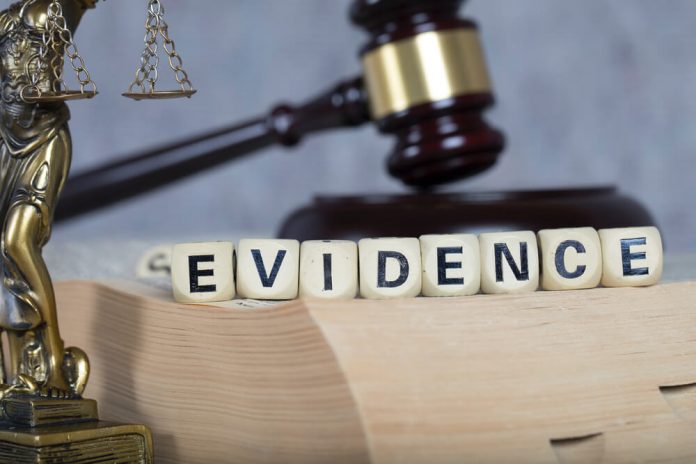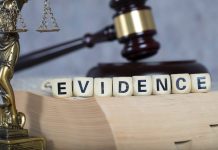This article is written by Michael Shriney from the Sathyabama Institute of Science and Technology. This article discusses Section 9 of the Indian Evidence Act, 1872 in detail, including its fundamentals, illustrations, scope, and case laws.
It has been published by Rachit Garg.
Table of Contents
Introduction
The Indian Evidence Act, 1872, is a statute that governs statements made before a court of law and enables or requires witnesses to present them in connection to the facts under investigation. The Indian Evidence Act of 1872 was written by Sir James Fitzjames Stephen. The goal of the Act is to lay forth the guidelines for kinds or the procedure in which evidence is accepted in Indian courts. The Act applies to the facts that are relevant and should be considered by the court; admissions, testimonies, oral evidence, documentary evidence, legal presumption, the burden of proof, estoppel, and all other matters involving in the acquisition of evidence and admissibility of issues on which the court must record its observations.
Section 9 of the Indian Evidence Act of 1872 deals with the facts that must be explained nor introduced as an issue of an argument in a lawsuit. In this Section, it is stated what facts are necessary, what facts are to be introduced as facts in the issue, and what are relevant facts. With an example, the concept would be more clear. For example, ‘Akhil’ accused ‘Bhaskar’ of stabbing ‘Chandran.’ In this situation, the facts stated by ‘Akhil’ are necessary. The facts were given by ‘Bhaskar’ who opposed that he did not kill ‘Chandran’ which is the question in hand, i.e., facts in issue. When ‘Denny’ recalls a fact that ‘Bhaskar’ had a knife in his hand when he entered ‘Chandran’s home and saw Chandran dead,’ the fact is relevant to the case. This example demonstrates which facts are made necessary, which facts are introduced as facts in issue, and which facts are important under this Section.
What is Section 9 of the Indian Evidence Act, 1972
The following are the facts that are necessary to explain or present significant facts in the matter before the court, as stated in Section 9 of the Indian Evidence Act of 1872 :
- Facts that are required to be explained, or
- Introducing a fact in the dispute, or
- Relevant facts to be produced in regard to the matter before the court, or
- The facts that can be supported, or
- The facts that are rebutted as a result of an inference drawn from a fact at controversy, or
- The fact that establishes the identity of anything or anyone whose identity is relevant, or
- The facts that fix the time or place at which any fact in an issue or relevant fact occurred, or
- The fact that shows the relationship of parties by whom any such fact was transacted, is relevant to the extent that it is required for that purpose.
Illustrations of Section 9 of the Indian Evidence Act, 1972
Validity of a will
- The situation of A’s property and family at the time of the claimed ‘Will’ may be essential criteria in determining whether a certain document is the Will of ‘A.’ This is an example of a relevant fact.
Introducing facts in the issue
- When ‘A’ sues ‘B’ for false defamation, ‘B’ accuses ‘A’ of his disgusting behaviour. ‘B’ acknowledges that the matter stated to be defamed is a truthful fact. The position and relationship of the parties at the time when the defamed statement was published may be important facts to the facts in the issue. When there is no specific defamation dispute between ‘A’ and ‘B’, it is not considered a relevant dispute; but, when there is a dispute between them over false defamation, it is considered a relevant dispute.
Relevant fact
- ‘A’ is caught in the act of committing a crime. The fact that ‘A’ escaped from his residence as soon as the crime was committed, is important to the fact and affects the facts in dispute. The fact that he had an emergency business at the place towards which he went at the time when he left his home quickly is the excuse stated by ‘A’. Here, the court is uninterested in the details of the company, but the explanation of why it was necessary matters.
The relevant fact as explanatory
- ‘A’ files suit against ‘B’ for persuading ‘C’ to violate a contract he signed with ‘A’. “I am leaving you because B has provided me with a better deal“, ‘C’ says to ‘A’ as he leaves A’s service. This statement is a relevant fact as an explanatory comment about C’s actions, which is a fact in dispute.
- ‘A’ was found guilty of stealing, and it was seen that he gave the stolen stuff to ‘B,’ who then gave it to A’s wife. “A says you have to hide this” ‘B’ adds as he gives it. B’s statement is significant since it explains a fact that is part of the transaction.
- ‘A’ is charged with rioting and is found to have marched in front of a crowd. The crowd’s screams are significant because they explain the nature of the transaction.
Conditions for the applicability of Section 9 of the Indian Evidence Act,1972
The Section’s applicability is either due to the fact that it is explanatory or introductory in nature. The following are the conditions in which this Section should be applied in a case:
- The facts must necessarily explain the facts in the issue or relevant facts; or
- The facts must necessarily introduce the facts in the issue or relevant facts; or
- The facts must necessarily support an inference or rebut the fact in issue or relevant fact; or
- The facts must prove the identity of anything or anybody whose identity is important or significant; or
- The facts must necessarily specify the time or place of the facts in issue; or
- The facts must always show the relation of persons involved in the transaction.
Scope of Section 9 of the Indian Evidence Act,1972
- Explanatory facts
When the facts are viewed alone, certain evidence has no meaning, but when they are interpreted in connection with other facts in a case, they become meaningful. Such facts are significant or relevant facts that must be appropriately communicated.
Consider the following scenario: Alexander attempted to kidnap a girl. During the course of the police inquiry, the accused was seen wandering around near the police station. When the girl spotted the accused, she began to cry in front of her brother, who reported the incident to the police. The accused was arrested by the police. The girl’s statement is self-explanatory.
- Introductory facts
When facts serve as an introduction to a key fact, they help in understanding the true nature of a significant transaction. Evidence is permitted only to the degree that it is used to introduce facts in the dispute or relevant facts.
- Facts supporting inference
This category of fact is neither relevant as facts in an issue nor relevant facts, but it supports or opposes the inference provided by the facts in the issue or relevant facts.
For example, when ‘A’ murders ‘B’, ‘A’ tries to flee from the village. The fact that he managed to flee is a supporting inference in regard to the murder he committed. This is a relevant fact.
- Facts rebut inference
With inferences given or relevant facts, the fact might be rebutted or disproved to the facts in the issue.
- Facts establishing the identity of a thing or person
When the identification of a thing is at issue, the information that is most beneficial in determining its identity is considered relevant facts.
For example: When ‘A’ conducts a heist that ends in a murder, the housekeeper is asked to identify the stolen items and the deceased objects. The clothing and shoes of the deceased can be used to identify them. The victim’s jewellery is acceptable if it was identified by a neighbour who attended a party in his home.
Identification of person:
Identification of a person is covered by Section 9 of the Indian Evidence Act of 1872. When a person’s identity is being investigated in a relevant matter, identification might be done by parents, siblings, wives, or other relatives. Identification can be detected in certain cases by a physical mark, sign, or any wound on the body. Medical examinations, such as bones, skeletons, age, voice, and so on, are also used to identify a person. Expert identification is achievable owing to the discovery of handwriting, finger and footprints, and other clues. Various approaches and methods are used to identify a person. The purpose of the identity test is to assist the investigative agency. When family members do not identify the gold that belonged to the deceased individual, but the gold’s owner does. It will be decided that his testimony could not be trusted. It is impossible to dismiss the jewels if family members have lost their memories. Identification evidence is considered substantial evidence in court.
Test Identification Parade (TIP)
The ‘Test Identification Parade’ is one of the ways of determining the identity of the accused. The purpose of the tests is to allow an eyewitness to the occurrence to identify the accused before the Magistrate. The identification of the test is absolutely required. The goal of test identification is to evaluate an eyewitness’ recollection and for the prosecution to determine who can be called an eyewitness. The court may consider identification or supporting evidence in some situations. It would be impossible to accept the identification of an accused by a minor witness without confirmation in court, or the identification of an accused by a witness for the first time without confirmation.
Relevant case laws pertaining to TIP
Heera v. State of Rajasthan (2007)
This specific case involves dacoity in relation to a parade test identification. Seven dacoits broke the door of a Petrol pump office to steal money in the middle of the night while workers were sleeping in the office. The three dacoits who entered the office battered the workers with lathis. Hearing the worker’s cries, a nearby neighbour came to the scene and was thrashed by the dacoits as well. The criminals stole money from the cash box and escaped. During the trial, thirty-seven witnesses were questioned. The suspects were identified using a Test Identification of Parade.
The following principles are established for holding the Test Identification of Parade (TIP):
- The Test Identification of Parade (TIP) is not considered significant evidence. These are used to verify the information.
- The major goal is to put the witness’s memory to the test during the inquiry stage.
- The Test Identification of Parade (TIP) procedure begins as soon as the accused is arrested.
- Appreciation will be based on the authenticity of the eyewitnesses.
Rajnath Singh, Mahatim Singh, Ram Manam, Munnu Alias Monu v. State of Uttar Pradesh (1978)
This case involves dacoity in relation to a Test Identification of Parade. At night, four dacoits break into Sheo Shanker Tiwari’s residence in Sakkapur village. They barged into the house carrying weapons such as a gun, a knife and lathis. They also carried torches. These dacoits tied the family to their beds while they were asleep. They were being threatened with weapons by the daicots. They took items and escaped from home. They discovered one of the dacoits names and filed a complaint against him. The names of the others were unknown, but the family recognized them. They were identified by the parade test. The eyewitness tracked down the others, who were arrested and punished.
Value of identification
The value of Identification is beneficial to both the investigative agency and the accused. Even if the witness is not connected with the accused, he may be able to identify the offender provided a test identification parade is organized as soon as possible.
Identification in court
Section 9 of the Indian Evidence Act, 1872, established the rule to identify the accused as the identification in court. The person identifying in court must confirm the accused’s identity, and the person identifying in test identification must verify the same.
Photo identification
There is no legal need for the accused to be identified by displaying images to witnesses. In practice, the police show the photos to the witness to ensure that the offender is properly identified. Photograph identification is not required to be given to the witness if the culprit is apparent in video identification. After nearly seven years of photography, it can no longer be trusted.
R v. Tolson (1864)
This case is about photograph identification. In order to confirm the first husband’s identification with the person who attended his marriage as a witness on the marriage certificate. The photograph was acceptable as evidence to identify the image’s visual representation of the accused person. The witnesses talk from their recollections of the event through photos. This is just an identification of an accused based on images recognized by witnesses. As a result, the Court decided that pictures, drawings and photofits of crime scenes may be accepted.
Conclusion
The article finishes by summarising Section 9 of the Indian Evidence Act of 1872. The facts are classified as either explanatory or introductory to the relevant facts or facts at issue. The facts must be explained or introduced, and they must be relevant or supportive to the court’s argument. It can also be rebutted if an inference is drawn from a disputed fact, and otherwise, it can identify anything or anybody related to the fact or facts in the issue or when the relevant facts occur. The information that demonstrates the relationship between the parties involved in the transaction must also be relevant to the facts.
Different tests are also utilized to determine the facts that can be presented as evidence in court by identifying facts. The identification parade test is used to assess the memory of an eyewitness against the accused. The identification of a person is the process of identifying an accused person or a deceased person using any markings or an identification examination, or through identifying family members. It is also detected through picture identification, which is utilized by authorities to identify the perpetrator from eyewitnesses.
References
- https://www.shareyouressays.com/knowledge/section-9-of-the-indian-evidence-act-1872-2/120396
- https://www.happyhealthysociety.com/section-9-iea-tip/
Students of Lawsikho courses regularly produce writing assignments and work on practical exercises as a part of their coursework and develop themselves in real-life practical skills.
LawSikho has created a telegram group for exchanging legal knowledge, referrals, and various opportunities. You can click on this link and join:
Follow us on Instagram and subscribe to our YouTube channel for more amazing legal content.
 Serato DJ Crack 2025Serato DJ PRO Crack
Serato DJ Crack 2025Serato DJ PRO Crack











 Allow notifications
Allow notifications



